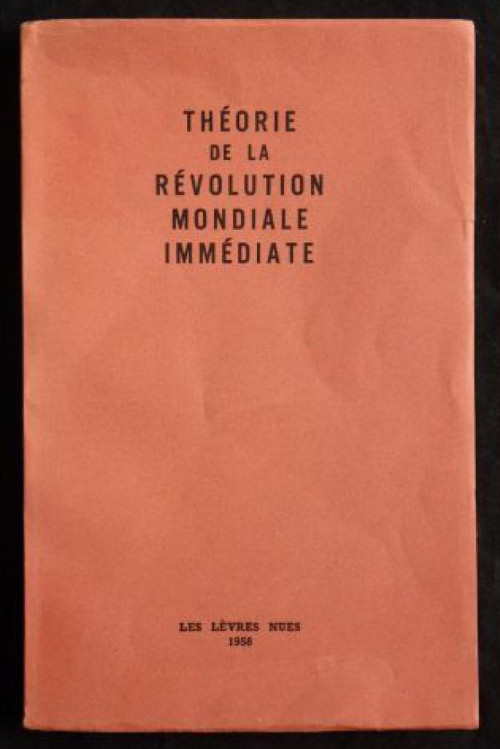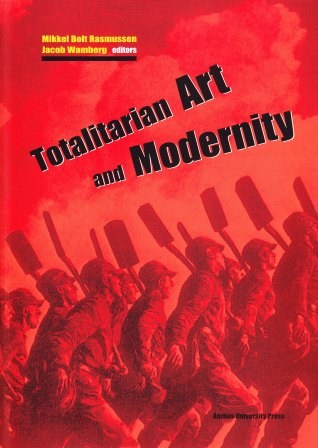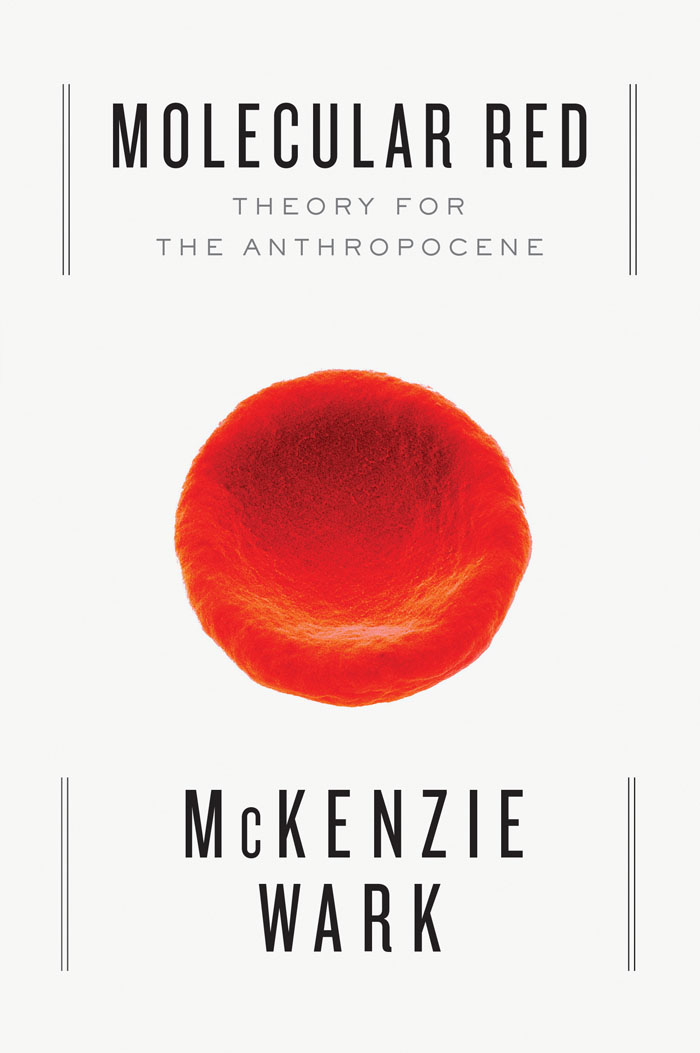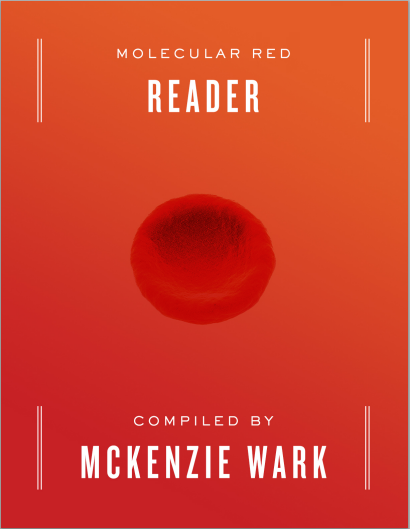Marcel Marïen: Théorie de la révolution mondiale immédiate (1958) [French]
Filed under book | Tags: · advertising, capitalism, politics, revolution, spectacle

“Théorie de la revolution mondiale immediate was part of a triple issue of Marïen’s journal Les lèvres nues and ends its first series. It was later published as a stand-alone book. Its avowed purpose was “a sketch of an imaginary program for the overthrow of capitalism in every part of the world it controls, to be completed within a year, with a program applicable at any moment and everywhere at the same time.” (45)
The first half of the text is an analysis of contemporary capitalism under the shadow of nuclear annihilation. These days one might worry more about the Anthropocene, but rhetorically, the problem is similar: how to think a revolution at a time when it appears both absolutely necessary and extremely unlikely.
The first part is a sound analysis of the stage commodification had reached by the late fifties, And bears comparison with the better remembered texts of the time. The very success of the worker’s movement in its reformist form had produced a leisure culture. Workers were becoming petit-bourgeois in outlook. Technical change had raised up a cadre of educated workers. Communist propaganda no longer worked very well, whereas capitalist propaganda was making inroads into the unconscious of the working class.
The second part is more surrealist science fiction than social science. For the project there is to use the spectacle itself for revolutionary ends. The form of revolutionary organization is the advertising agency. It is to be called the Leisure Club. It creates advertising and popular media addressed to every diverse pastime, hobby or consumer preference – all to be worked out using the latest social science techniques. […]
While there are charming features of the book that date it, there are also many ways in which it is strikingly contemporary. As Sven Lütticken has pointed out, it is quite likely that former Tiqqun people borrowed the rhetoric of the Invisible Committee and the Imaginary Party from Mariën. One might also think it an anticipation of Adbusters, or even the strategies of Podemos in Spain, which seems to retain a model of the party of the interior while using contemporary marketing techniques.” (taken from McKenzie Wark’s 2016 essay)
Publisher Les Lèvres nues, 1958
111 pages
via Marcell via Ken
PDF (36 MB)
Comment (0)Mikkel Bolt Rasmussen, Jacob Wamberg (eds.): Totalitarian Art and Modernity (2010)
Filed under book | Tags: · art history, avant-garde, capitalism, communism, democracy, fascism, labour, modernism, modernity, monument, mythology, nazism, politics, revolution, socialism, socialist realism, soviet union, technology, totalitarianism, war

“In spite of the steadily expanding concept of art in the Western world, art made in twentieth-century totalitarian regimes – notably Nazi Germany, fascist Italy and the communist East Bloc countries – is still to a surprising degree excluded from mainstream art history and the exhibits of art museums. In contrast to earlier art made to promote princely or ecclesiastical power, this kind of visual culture seems to somehow not fulfill the category of ‘true’ art, instead being marginalised as propaganda for politically suspect regimes.
Totalitarian Art and Modernity wants to modify this displacement, comparing totalitarian art with modernist and avant-garde movements; confronting their cultural and political embeddings; and writing forth their common generalogies. Its eleven articles include topics as varied as: the concept of totalitarianism and totalitarian art, totalitarian exhibitions, monuments and architecture, forerunners of totalitarian art in romanticism and heroic realism, and diverse receptions of totalitarian art in democratic cultures.”
With contributions by Mikkel Bolt, Sandra Esslinger, Jørn Guldberg, Paul Jaskot, Jacob Wamberg, Christina Kiaer, Anders V. Munch, Kristine Nielsen, Olaf Peters, K. Andrea Rusnock, and Marla Stone.
Publisher Aarhus University Press, Århus, 2010
Acta Jutlandica series, 9
ISBN 8779345603, 9788779345607
359 pages
via Mikkel Bolt
PDF (10 MB)
Comment (0)McKenzie Wark: Molecular Red: Theory for the Anthropocene (2015)
Filed under book | Tags: · agriculture, anthropocene, climate, climate crisis, communism, cyborg, environment, knowledge, labour, literary criticism, marxism, nature, philosophy, production, proletariat, proletkult, revolution, science, science fiction, technoscience, tektology, theory, utopia


“In Molecular Red, McKenzie Wark creates philosophical tools for the Anthropocene, our new planetary epoch, in which human and natural forces are so entwined that the future of one determines that of the other.
Wark explores the implications of Anthropocene through the story of two empires, the Soviet and then the American. The fall of the former prefigures that of the latter. From the ruins of these mighty histories, Wark salvages ideas to help us picture what kind of worlds collective labor might yet build. From the Russian revolution, Wark unearths the work of Alexander Bogdanov—Lenin’s rival—as well as the great Proletkult writer and engineer Andrey Platonov.
The Soviet experiment emerges from the past as an allegory for the new organizational challenges of our time. From deep within the Californian military-entertainment complex, Wark retrieves Donna Haraway‘s cyborg critique and science fiction writer Kim Stanley Robinson’s Martian utopia as powerful resources for rethinking and remaking the world that climate change has wrought. Molecular Red proposes an alternative realism, where hope is found in what remains and endures.”
Publisher Verso, London and New York, March 2015
ISBN 1781688273, 9781781688274
xxiv+280 pages
Reviews: Slavoj Žižek (Verso 2015, Wark’s response), John Beck (Radical Philosophy 2015), Mark Rappolt (ArtReview 2015), Maria Chehonadskih (Mute 2015, Wark’s response), Two Grenadiers (2015), Pieter Vermeulen & Tom Chadwick (nY 2016), Jim Harper (LSE Review of Books 2016).
Commentary: Joe Guinan (Renewal 2015), Jernej Kaluža (Radio Student 2019, SL).
Video lecture (Concordia U, Apr 2015)
Publisher
WorldCat
See also Molecular Red Reader compiled by Wark (PDF).
Comment (0)
